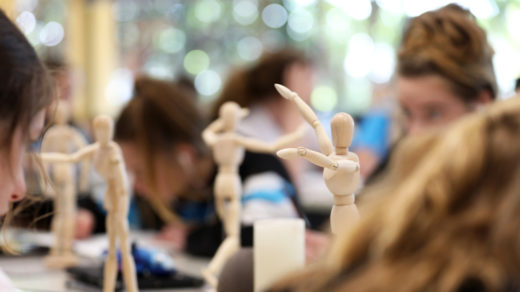 Today’s schools are preparing children, starting at an early age, for future educational and career opportunities that will help them succeed. With strict standards that must be met, measured in part by testing, it’s not unusual for both time and funding to be shifted away from arts education to achieve this goal.
Today’s schools are preparing children, starting at an early age, for future educational and career opportunities that will help them succeed. With strict standards that must be met, measured in part by testing, it’s not unusual for both time and funding to be shifted away from arts education to achieve this goal.
While this might seem like a reasonable reaction at first, it overlooks an important fact. Numerous studies correlate arts, music and theater programs with creating future opportunities for children, up to and including increasing their rates of enrollment in higher education.
The urgency of this disparity drives an annual National Arts in Education Week, observed just last month. The congressionally backed advocacy event encourages teachers, students, parents and advocates to get involved in protecting arts education at both local and national levels.
Arts education has the potential to deliver long-term positive impact to children. The following three benefits demonstrate how study of the arts, music and theater bolster kids at their current grade level and prepare them for ongoing success.
1. Increases enrollment in institutions of higher education. Socioeconomic status has long been a driving factor in whether students go on to attend higher education. Children from higher-income backgrounds have the ability to access the preparatory courses and opportunities that position them for future success, while those from low-income backgrounds often miss out. A collection of four studies presented by the National Endowment for the Arts has shown that participation in arts education is one way to narrow this gap to the benefit of underserved populations.
The research, which assessed the longitudinal impact of arts education on an at-risk population of children from low socioeconomic backgrounds, determined two related things: High levels of engagement in arts education are directly linked to higher levels of college aspiration, and low-income children who participate in arts education programs are twice as likely as non-participating counterparts to earn a college degree in the future.
2. Reduces rates of dropping out. For students who come from socioeconomically disadvantaged backgrounds and those with special needs, the statistical risk of dropping out of high school is significant. Doing so deprives these children of important educational, career and developmental opportunities.
In a Florida State University study on the role of fine and performing arts participation in dropout prevention, at-risk students said the time they spend in their school’s arts programs was a driving factor keeping them in school. This may be because art classes provide positive and supportive environments where students can safely take risks, engage actively and master a discipline.
3. Balances levels of academic achievement between socioeconomic classes. For the same reasons that socioeconomically disadvantaged students are at risk of dropping out early or missing out on higher education opportunities, this underserved population also historically underperforms academically when compared with more advantaged peers. This is not for lack of skill.
A Mississippi State University study assessed more than 5,000 students as they participated in a new educational model that integrated arts education into the curriculum in new, more immersive ways. The result was drastic improvement, with schools participating in the new arts education program demonstrating significantly higher standardized test scores than those who did not participate.
The positive impact doesn’t stop there. A 1998 study by Stanford University and the Carnegie Foundation for the Advancement of Teaching discovered that students who participate in three hours of arts education on three disparate school days are four times as likely to receive academic recognition and participate in math and science fairs, and three times as likely to hold class office and be recognized for good attendance.
The number of studies that associate time spent in arts education with positive outcomes for children are plentiful and hard to ignore. An essential part of advocating for higher education access is to preserve and advocate for the funding, backing and time that school arts programs need to survive on all levels.
Neve Spicer is founder & director of WeTheParents.org, an evidence-based parenting resource that explores the intersection between creativity, play and education.
Related Posts:
Tuning In: Six Benefits of Music Education for Kids
Letting Off STEAM at Montserrat College of Art
Summer 2005 Journal: The Creative Region
Summer 1998 Journal: Arts Make Mighty Impact on New England, But Face Critical Challenges
[ssba]
